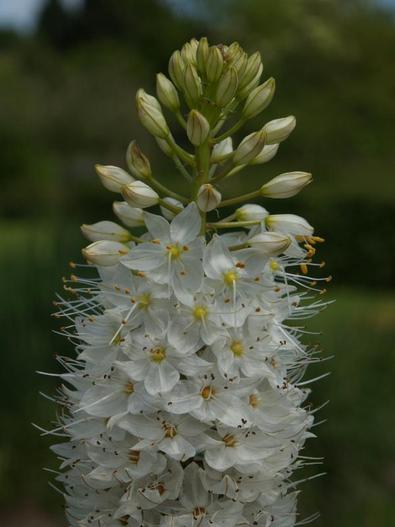Himalayan Foxtail Lily
(Eremurus himalaicus)
Himalayan Foxtail Lily (Eremurus himalaicus)
/
/

Wayne Boucher
CC BY-SA 2.5
Image By:
Wayne Boucher
Recorded By:
Copyright:
CC BY-SA 2.5
Copyright Notice:
Photo by: Wayne Boucher | License Type: CC BY-SA 2.5 | License URL: https://creativecommons.org/licenses/by-sa/2.5 | Uploader: Epibase | Publisher: Wikipedia Commons





Estimated Native Range
Summary
Eremurus himalaicus, commonly known as Himalayan Foxtail Lily, is a deciduous perennial bulb native to the open slopes and alpine meadows of the Himalayas, specifically in regions of Pakistan and Afghanistan. It can reach heights of 4-6 feet (1.2-1.8 meters) and a width of 1-2 feet (0.3-0.6 meters). This plant is characterized by its tall, dramatic spires of densely packed flowers, which are typically white and highly showy, blooming in late spring to early summer. The long inflorescences are eye-catching and add vertical interest to garden settings.
The Himalayan Foxtail Lily is valued for its striking flower spikes that can provide a focal point in borders and cottage gardens. It is also used in cut flower arrangements due to the longevity of its blooms. Gardeners appreciate its ease of maintenance, provided it is planted in well-drained soil. It requires full sun to thrive and prefers a sandy, loamy soil with good drainage. While it needs regular watering during the growing season, it is important to reduce watering after the foliage dies back to prevent bulb rot. There are no major disease problems, but it can be susceptible to slug and snail damage. The bulbs should be planted in a sheltered spot to protect them from strong winds.CC BY-SA 4.0
The Himalayan Foxtail Lily is valued for its striking flower spikes that can provide a focal point in borders and cottage gardens. It is also used in cut flower arrangements due to the longevity of its blooms. Gardeners appreciate its ease of maintenance, provided it is planted in well-drained soil. It requires full sun to thrive and prefers a sandy, loamy soil with good drainage. While it needs regular watering during the growing season, it is important to reduce watering after the foliage dies back to prevent bulb rot. There are no major disease problems, but it can be susceptible to slug and snail damage. The bulbs should be planted in a sheltered spot to protect them from strong winds.CC BY-SA 4.0
Plant Description
- Plant Type: Bulb
- Height: 5-8 feet
- Width: 1-2 feet
- Growth Rate: Moderate
- Flower Color: White
- Flowering Season: Spring, Summer
- Leaf Retention: Deciduous
Growth Requirements
- Sun: Full Sun
- Water: Medium
- Drainage: Medium, Fast
Common Uses
Bank Stabilization, Deer Resistant, Drought Tolerant, Fragrant, Showy Flowers
Natural Habitat
Open slopes and alpine meadows of the Himalayas
Other Names
Common Names: Himalayan Desert Candle, Foxtail Lily, Himalaya-Steppenkerze, Vit Stäpplilja
Scientific Names: , Eremurus himalaicus, Henningia himalaica,
GBIF Accepted Name: Eremurus himalaicus Baker